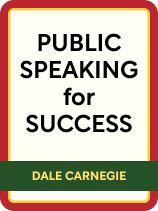

This article is an excerpt from the Shortform book guide to "Public Speaking for Success" by Dale Carnegie. Shortform has the world's best summaries and analyses of books you should be reading.
Like this article? Sign up for a free trial here.
How can public speaking help you tackle other fears you have in life? What should you do on the day of your speech? What should you keep in mind when you open and close a talk?
In Public Speaking for Success, Dale Carnegie says that public speaking is the one skill that can bring you more success, opportunity, and fulfillment than any other. You can change people’s hearts and minds, inspire action, improve your relationships, and succeed in life and work.
Continue reading for an overview of this classic book on public speaking, and find out why it endures.
Overview of Public Speaking for Success by Dale Carnegie
In Public Speaking for Success, Dale Carnegie argues that anyone can learn to speak with confidence and poise regardless of prior experience or the all-too-common fear of speaking in public. By following his lessons, Carnegie says, you’ll be well on your way to owning your voice and the stage.
Carnegie was an author and lecturer most famous for his 1936 bestseller How to Win Friends and Influence People. Less known is that he actually got his start in public speaking—beginning as a speech tutor in high school, later launching a YMCA speaking class, and eventually founding the Dale Carnegie Institute to handle the demand for his lessons.
Our overview is based on the updated 2006 edition of Public Speaking for Success (originally published in 1926 as Public Speaking: A Practical Course for Business Men). While the updated edition includes basic English lessons on grammar, spelling, and diction, our overview focuses on the core of Carnegie’s classic public speaking lessons. We’ll present them in three sections:
- Part 1: Why public speaking matters and how to overcome the fear of getting up onstage
- Part 2: How to select a topic, develop your ideas, and memorize your speech
- Part 3: How to prepare day-of, open your speech, hold the audience, and close memorably
Why Learn Public Speaking?
To begin, we’ll explain why Carnegie says public speaking is such a valuable skill. We’ll also discuss how to get past the fear of speaking and start owning the stage.
Succeed in Life and Work
According to Carnegie, public speaking can yield more benefits than any other life skill. Carnegie suggests that effective public speakers change people’s minds and hearts, influence the discourse on societal and cultural issues, drive businesses’ growth, and much more.
Specifically, becoming a skillful public speaker can give you:
Influence at work: Carnegie says that speaking well can improve your social standing, which he argues determines your professional success. Great speakers can befriend and influence colleagues, sway decisions, and build stellar reputations in their fields.
Influence at home: According to Carnegie, public speaking is just skillful communication writ large, so it’ll also help you improve relationships with friends and family.
Build Your Self-Confidence
More than just increasing your influence, learning to speak in public will also boost your confidence because it requires you to overcome what for most people is a significant fear. In doing so, you’ll show yourself what you’re truly capable of. And, according to Carnegie, that newfound self-confidence will ripple out into other areas of your life.
Before you start learning the skill, take the time to face any fear you may feel of public speaking. Carnegie argues that it’s perfectly possible to overcome such fear and that it’s completely natural to be afraid at first. Learning to speak confidently in front of large groups is not an inborn talent, but a skill that everyone has to learn. According to Carnegie, even famous speakers such as Abraham Lincoln struggled in the beginning.
To overcome your fear, use Carnegie’s four tactics:
Tactic #1: See yourself succeeding. In other words, imagine the version of yourself you want to become. Hold that vision firmly and you’ll get there in time.
Tactic #2: Practice consistently. Confidence comes through experience, so look for opportunities to speak. Start with small groups, even just family or friends. Over time you’ll steel your nerves and be ready for more.
Tactic #3: Persist through plateaus. Carnegie explains that we don’t acquire new skills linearly—rather, we learn in fits and starts. Remember this when you worry you’ve stalled, and persist to your next big burst of growth.
Tactic #4: Commit and follow through. If you don’t give up, you’ll reach success in public speaking as a matter of course. Believe in yourself, practice, persist, and you will become a competent speaker.
Preparing Your Speech
Once you’ve decided to pursue the benefits of public speaking and not let fear hold you back, you’ll need to start preparing a speech. The best speeches, Carnegie asserts, are extensively prepared ahead of time. Taking the time to thoroughly develop your speech will ensure that you’ll give it with ease, enthusiasm, and poise.
To help you achieve this, we’ll detail Carnegie’s strategies for selecting your topic, determining your speech’s objective, structuring your ideas, and memorizing what you’ll say.
Selecting a Topic and Developing Your Ideas
According to Carnegie, a powerful speech blends reason and emotion to truly reach an audience. To that end, Carnegie advises that you:
- Know your topic, ideas, and argument like the back of your hand.
- Become emotionally invested in the case you want to make.
When you thoroughly understand and deeply feel your topic, you’ll deliver a speech that just works. Your emotions will fuel and animate your speech-giving, while your rock-solid information will persuade even the most intelligent and discerning audiences.
Carnegie says that, to achieve this combination of knowledge and emotional investment, you need to pick a topic that you already feel strongly about. This guarantees you’ll speak with enough passion. In addition, choose your topic as far in advance as you can—weeks or even months prior—so that you have plenty of time to prepare.
From there, give your ideas time to develop. The key to developing your ideas, Carnegie says, is to constantly keep them top of mind. Mull them over as you have breakfast or on the way to work. Discuss them with family and friends. Think about them as you go to sleep or take walks. All along the way, keep a notebook in which you record and reflect on your ideas. Doing so will help you find and develop connections as well as new directions to explore within your topic. As your ideas unfold, be sure not to limit what you write down. When it comes time to write your speech, you’ll have an abundance of material from which to distill a clear, focused point of view.
Carnegie additionally recommends these tactics for developing your ideas:
- Ask questions about your topic. Question your own standpoint, question other perspectives, question the received wisdom.
- Research your topic. First, develop your thinking. Then, find books that give you details as well as a bird’s-eye view of the topic. Get all the facts and positions straight so you’re completely prepared.
Aim Your Speech at a Main Objective
Once you’ve developed your ideas, think about the purpose of your speech. All speeches, Carnegie asserts, have one of four main objectives:
- To elucidate and educate
- To persuade people of a position
- To inspire people to take action
- To captivate and entertain
In the following four sections, we’ll explain how to achieve each of these ends.
Regardless of your main objective, some strategies will always work. Carnegie emphasizes that you should always:
Captivate yourself before you captivate the audience: Become so deeply interested in your ideas that the audience can’t help but pick up on your enthusiasm and conviction.
Liberally repeat your key points: Carnegie explains that hearing an idea repeated often persuades people that it’s true. Be sure to vary your phrasing to obscure the repetitions and hold your audience’s attention.
Favor concrete explanations: Concrete words illustrate ideas in a much “stickier” and more tangible way than abstract words. Compare the abstract statement, “he was seven feet tall,” with the more concrete, “he was so tall that his head scraped the ceiling!”
Objective #1: Elucidate and Educate
Regardless of your objective, clarity is key—however, this is particularly true of speeches that seek to educate audiences about complex or important topics.
According to Carnegie, clarity is the speaker’s responsibility—not the audience’s. Put another way, consider it to be your fault if the audience can’t follow what you want to say. To ensure that you’re perfectly clear, use the following tactics:
- Articulate your ideas succinctly. On the level of the sentence, revise each idea until the fluff is gone and the core point shines through. On the level of the speech, fit your argument to the time available—otherwise, you won’t be able to properly explain each idea.
- Relate your points to familiar ideas. When explaining unfamiliar topics—say, AI chatbots—relate them to tangible, everyday ideas.
- Tailor your language to the audience. If you have a technical audience, feel free to use industry-specific jargon. If your audience is more general, use language plain enough that a child could understand.
- Illustrate abstractions. Use charts, images, or graphs to clarify your points when explaining numbers, data, or other abstractions.
- Recap your argument. Following long sections or the entirety of your speech, give summaries that refresh the main points for your audience.
Objective #2: Persuade
When you want to persuade an audience of some position, Carnegie recommends that you use enthusiasm, force, and repetition (in addition to a well-formed argument) to fix your idea in their minds. This works because, according to Carnegie, people have a harder time finding smart objections to an idea than simply accepting it.
Carnegie says that unless your ideas have obvious flaws, people will generally take you at your word. Given this, you can craft a persuasive speech by 1) repeatedly impressing your ideas upon the audience, and 2) actively addressing any doubts or objections. To these ends, Carnegie recommends these tactics:
- Speak with great enthusiasm. Enthusiasm is infectious and will spread from passionate speakers to their audiences.
- Find the flaws in your ideas. Think of any likely objections ahead of time, then address them in your speech to allay doubt.
- Quote authorities. Find quotes from well-known people that support your points—people will more quickly believe known experts.
Objective #3: Inspire Action
One of the most powerful things a speech can do is move people to action. Carnegie recommends a four-step process for achieving this objective:
- Use a strong opening to get the audience’s attention (we’ll explain how below).
- Earn the audience’s trust. Introduce yourself with key points about your background, experience, and qualifications. Then, speak sincerely and from your own experience, rather than using abstractions.
- Make your argument. Introduce one idea at a time, and logically build each subsequent idea toward your conclusion. Then answer objections—as many as you can—to demonstrate that you aren’t afraid of scrutiny.
- Appeal to people’s emotions, which drive us more than reason does. You can appeal to desires such as personal gain, safety, happiness, and self-esteem, or to moral or patriotic ideals, such as fairness, equality, liberty, and faith.
Objective #4: Entertain and Inform
You don’t always have to educate, persuade, or inspire action—instead, Carnegie says you can speak just to entertain or inform an audience on an interesting topic. To that end, you can employ any technique we’ve discussed so far, as well as the following tactics:
- Provide novelty. We all love to be amazed by new, unexpected information.
- Appeal to people’s self-interest. How do your ideas matter to your audience? How do they affect their lives, ambitions, or fortunes?
- Use human interest stories. People also love stories about other people—their triumphs, failures, struggles, and successes. Make just a few points and then spend most of your time illustrating them with stories and examples.
Structure and Arrange Your Ideas
Now that you’ve begun to develop your ideas and aim them toward a main objective, start setting out the structure of your speech. According to Carnegie, your speech needs a clear opening, a focused trajectory or throughline, and a stirring conclusion. While there are no hard-and-fast rules for nailing down the nitty-gritty specifics within this framework, Carnegie offers the following templates to adapt to your needs:
- Template #1: Start with your premises; present your argument; call for action.
- Template #2: Draw attention to a problem; present your solution to it; call for action.
- Template #3: Captivate the audience; establish your credibility; give your argument; call for action.
Whichever template you start from, Carnegie also advises that you favor keeping your speech succinct and focused. Pick two or three key points to make about your topic, then refine them until they vividly and persuasively communicate your argument.
Last, Carnegie suggests dictating your speech to explore different ways of arranging the ideas. Speak aloud into a voice recorder as if you’re giving the speech, and you’ll begin to notice better ways of fitting the ideas together. Transcribe your dictations for editing in a word processor, and repeat this process until you’re sure of your structure.
Memorizing Your Speech
Once you finalize the structure of your speech, from macro to micro, you can start memorizing it. Carnegie says that this doesn’t necessarily mean learning each exact word and phrase by heart—rather, you can save time and enhance your delivery by thoroughly learning your argument, and then speaking extemporaneously. When you know your speech well enough, this will help you deliver it with conviction, feeling, and authenticity.
Speaking extemporaneously is possible because, Carnegie says, our memories are quite strong when we use the right techniques. He recommends three rules for using your memory effectively.
Rule #1: Create Lasting Impressions
As a general rule, memories stick best when you get a thorough and vivid impression of what you want to remember. Carnegie advises that you simply focus hard on a mental image, like a blooming flower, until it unfolds in vivid detail. Use all your senses to concentrate and feel, taste, hear, smell, and see the image.
Rule #2: Liberally Associate Your Memories
Once you have a strong image for each of your ideas, begin to weave them together. According to Carnegie, the brain is an associative machine: We create and access memories by linking them together with other memories. So, to further memorize your speech, take those images you created and link them together as a sort of “road trip” through your ideas. Shape the images into a narrative sequence, associating each point with a stop along the way.
Rule #3: Practice by Repetition
Once you’ve created strong impressions and linked them together, practice recalling those memories. Practice by repetition is like walking the same path until it becomes well-worn and clear of obstructions. However, don’t practice every day—instead, practice in intervals of a few days, and increase the gaps as time goes on. Studies have found that this strengthens memories to the same degree as daily practice in around half the time.
Lastly, Carnegie recommends combining the above techniques to create a mental narrative that traces the path of your speech. To do this, number each point in your speech. Then, create a strong mental image for each number. Link those images to each corresponding point, then string them together in a mental story based on your images. Rehearse that story, and you’ll recall your points easily and in order.
Giving Your Speech
Once you’ve prepared, polished, and memorized your speech, it’s time to get ready and give it. In this section, we’ll discuss Carnegie’s recommendations for making last-minute preparations, giving a strong opening, holding the audience’s attention, and closing memorably.
Preparing for the Day of Your Speech
Having put in the work to prepare for your speech, you’ll want to be ready for the day of. Carnegie recommends that you rest up before your speech: Get a good night’s sleep to rejuvenate mentally, physically, and emotionally. Also, to prevent brain fog, don’t eat before speaking.
Just prior to the day of, you’ll want to make sure the stage is properly prepared. Carnegie advises removing all clutter and furniture, apart from an unobtrusive podium, to minimize distractions. If you don’t have a stage, simply clear the area you’ll be occupying of clutter—and know that speaking from the same level as your audience makes the event more personal and comfortable.
As to the room itself, try to match its size to your audience. For a small audience, book a small room; book a large room for a larger audience. If audience members are sparse and scattered, Carnegie says you can ask them to gather in the center. This helps facilitate a crowd mentality, which makes people easier to engage with and persuade.
Carnegie advises that, right before the speech, you should dress and groom yourself well. Looking the part will help you deliver as well as impress your audience. Right before you take the stage, read your speech over once more, and rehearse what you’ve memorized.
Opening Your Speech
It’s now time to give your speech—so how do you engage and captivate your audience right from the start? According to Carnegie, the secret is simple: Deeply feel what you have to say, then speak from your heart rather than your head.
Having prepared ahead of time, you’ve learned your topic thoroughly and gotten all the facts straight. However, facts don’t convince—emotion does. So when it’s time to deliver, do so with passion, emotion, and great enthusiasm. If you haven’t built a strong emotional investment in your speech, your audience will notice and quickly lose interest—people can tell when you don’t really care about what you’re saying.
In more practical terms, Carnegie recommends the following tactics for successfully opening your speech:
- Pump yourself up. Right before your speech, get energized. Jump around, shake your fists in the air—feel your convictions and allow them to animate you and fire you up.
- Stand tall and act confident. Take the stage with poise and presence, and remind yourself that you are well-prepared, invested in your ideas, and here to educate an audience that came to listen to you.
- Cater to the audience. If they’re technical, you can open with familiar in-group words and ideas, like a Richard Feynman joke for a group of physicists.
Hook the Audience’s Attention
Beyond the above general advice, Carnegie explains that you must hook an audience’s attention. People are generally impatient, so you have to grab their attention very quickly—and this is best achieved with an opening that you design in advance to maximize your chance of success. Carnegie gives the following techniques:
- Keep it succinct. Refine your opening to a sharp, powerful sentence or two at max. Then charge ahead into your speech.
- Arouse curiosity. People are naturally curious—take advantage of their desire to know more with a shocking statement, novel information, or a captivating question.
- Appeal to self-interest. If your audience is practical or business-oriented, tell them how what you have to say will improve their lives or bottom lines.
- Find common ground. When your topic is contentious, open by tactfully speaking to shared experiences, values, or points of reference between you and the audience. This gives them a positive first impression and ensures they’ll listen to what you have to say.
Beyond what to do, Carnegie says, you can also improve your opening by avoiding the following common (and often ruinous) errors:
- Opening with an apology. Often used to seem humble, this technique makes speakers look incompetent or unprepared and can annoy audiences.
- Opening with humor. Most speakers can’t pull off jokes, so you’ll most likely make the audience cringe and pull away emotionally.
- Opening too formally. Scripted, overly rehearsed, and/or dry openings easily lose the audience’s attention.
Holding the Audience’s Attention
Once you’ve hooked the audience’s attention, you need to continue to earn it. According to Carnegie, you can do this by paying attention to how you speak and not just what you say. While he states that there are no hard-and-fast rules, Carnegie does recommend these techniques:
- Speak conversationally, as if you’re chatting with a close friend. This will bring out a natural, sincere quality in your voice and help the audience feel connected to you.
- Speak to individuals, not the crowd. After all, the audience is composed of individuals, and people generally appreciate being recognized and spoken to. Make eye contact; create connections.
- Let loose your individuality. Real stage presence comes from an authentic individual owning their personality. To truly own the stage, speak, move, and express yourself in whatever way feels most natural.
Remember also that your attitude influences your audience’s attitude—that is, they respond to the emotion you give off. To avoid appearing uncomfortable or awkward, stand tall and keep your hands relaxed at your sides. Let yourself gesture naturally, but avoid sharp or jerky movements. All in all, practice speaking spontaneously, authentically, and as only you can.
Closing Your Speech
To close a speech in a memorable way, leave the audience with a final, powerful, and clear restatement of your argument’s main thrust. According to Carnegie, there’s no perfect prescription for achieving this. You won’t do it that well in your first few speeches, but over time, you’ll develop a sense of when your point is clear and when the timing is right to end.
Generally, that point comes not long after the peak, or climax, of your speech. That is, once you’ve landed on the main, cumulative thrust of your argument, start looking to wrap the speech up. This works because you’ll stop while your audience is still enjoying your speech and leave them wanting more. If, in contrast, you drag things out, you’ll lose their interest.
Carnegie asserts that since endings are so important, you should plan yours out word for word. Write it out ahead of time, revise it, and try it out on friends and family to get feedback. Keep revising it and getting feedback until your helpers clearly feel roused by the ending. As you’re crafting your ending, consider Carnegie’s five techniques:
- Recap your argument. This refreshes your logic in the audience’s minds and helps them put the whole thing together.
- Call for action. Having made your argument, make a passionate statement as to what needs to be done about your topic.
- Thank your audience. If you sincerely feel it, express your pleasure, gratitude, or enjoyment at speaking for them.
- Use a famous quote. If a famous quote more powerfully sums up your argument than you could, take advantage of that fact.

———End of Preview———
Like what you just read? Read the rest of the world's best book summary and analysis of Dale Carnegie's "Public Speaking for Success" at Shortform.
Here's what you'll find in our full Public Speaking for Success summary:
- Why public speaking is one of the most important skills to have
- How to overcome the fear of public speaking and adopt poise
- How to research, write, and deliver a memorable speech






